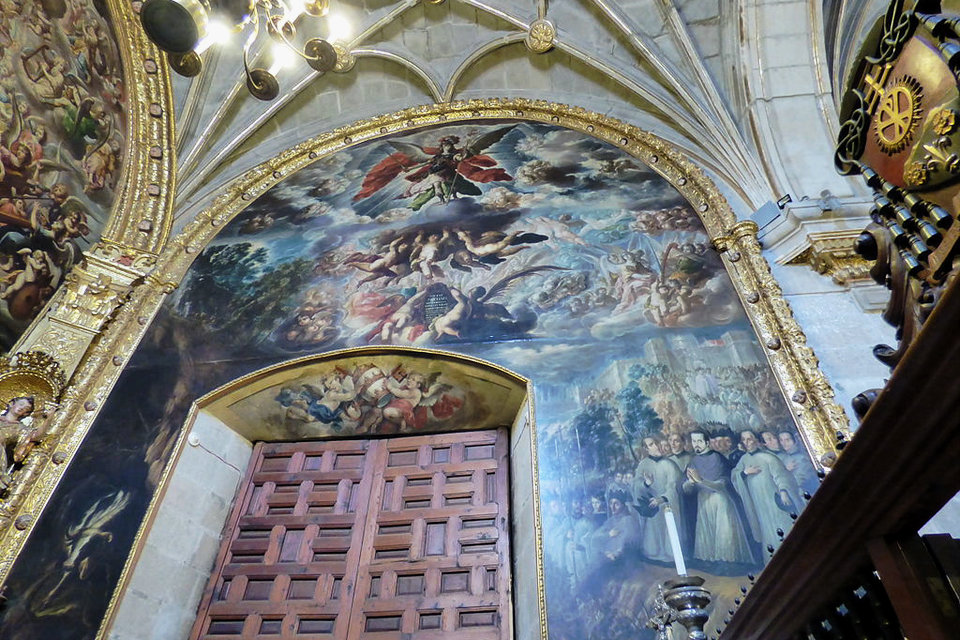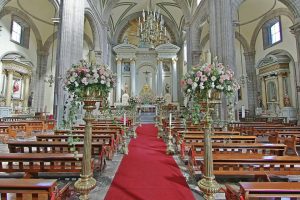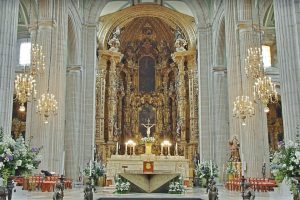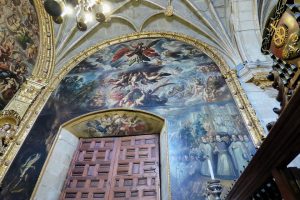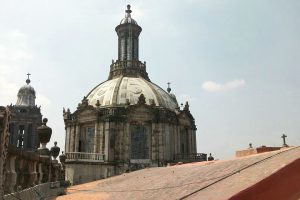It is the oldest space in the cathedral. In 1626, when the viceroy Rodrigo Pacheco y Osorio, Marquis de Cerralvo (1624-1635) ordered the demolition of the ancient temple, the Sacristy functioned (until 1641) as the place where the offices were held. Logically there was placed the main altar and according to the inventory of 1632, it had two lecterns, one of gilded iron and the other of silver made by the master Pedro Ceballos.
Inside the sacristy you can admire huge paintings by the Novohispano painters Cristóbal de Villalpando and Juan Correa. The titles of the paintings are: The Triumph of the Church, The appearance of San Miguel, The Woman of the Apocalypse (Villalpando); The Transit of the Virgin and the Entrance of Christ to Jerusalem (Correa). There is also a painting attributed to the Spanish painter Bartolomé Esteban Murillo.
There is not yet enough documentation to give an idea of the interior decoration that was presented between 1641 and 1684, but instead, if there are abundant ornaments and goldsmiths in the inventories of 1632, 1649, 1654 and 1669, giving clues about what there was.
The furniture it houses today is from the last third of the eighteenth century: cabinets and chest of drawers in balsam wood “that faithfully adhere to the precepts that San Carlos Borromeo formulated in this regard”, cardinal and archbishop of Milan, in his factory instructions and of the ecclesiastical ajuar of 1577
Juan de Viera comments that in the headwaters of the Sacristy there were “two mahogany tables from China, black as jet, where the chalices prepared for the sacrifice are placed, being their boards of a piece of two rods wide and two and a half of long”. And he continues to point out that the “caxonera” is made of “exquisite wood of Saongolica stick and others, with its golden locks and distributed in proportion, cupboards with doors of the same wood… and in the circumference… next to the caxones distant two rods, armchairs of the same mahogany. ” These drawers were recently altered due to apparently operating problems.
Toussaint’s 1948 book still records the trousseau of chairs with cabriola legs and a credenza with drawers of domed skirts, cabriola legs and claw, in addition to phytomorphic reliefs.
The cupboard for chalices, originally located on the west wall under the Virgin of the Apocalypse of Cristóbal de Villalpando, housed a large number of “gold chalices and glasses of the same metal trimmed of fine stones and other vessels and sacred vessels, candlesticks, pedestals, acheros of silver on gilthead and cruises… its wealth is much. Only gold and diamond custodians have five, without a new one that has cost 116,000 pesos. ” The inventory of 1662 accounts for the aquamaniles, one of them by the silversmith Ena.
In 1957, the wooden perimeter floor and floor were changed to another stepped stone; a twin fence was placed to the one of the Chapter room (adapted by the architect Antonio G. Muñoz) to vestibular the space creating an anteacristia. Master Soto also altered the original proportions of some drawers: the drawer was cut from the front wall and a “hybrid taste” mahogany oratory was placed in the center.
Finally, the canvas of the Virgin of Guadalupe with a donor, work of Francisco Martínez made in 1747 that remained a long time in the basement, now chairs the Guadalupana room of the old building of the Curia de la virgen de guadalupe
Sacristy of the Cathedral of Mexico
The sacristy of the Cathedral of Mexico forms parallel to the chapter room, as well in its dimensions as in its structure and even on its cover. It is this, the one that communicates the processional ship of the Epistle with the interior of the enclosure, one of the purest samples that has left in Mexico the art known as the herreriano or desornamentado. The large semicircular arch rests on sober pilasters. In his archivuelta the inscription that dates the work can be read: “BEING COMMISSARY THE LORD OIDOR ALONSO VAZQUEZ DE CISNEROS MADE THIS COVER AND CLOSED THIS SACRISTIA. YEAR OF 1623”.
Within this archway, the architecture of the cover moves: two Doric pilasters support a sober entablature with a closed triangular pediment. The door is a semicircular arch over more sober pilasters, since they are not striated like the others, but simply present a recessed caseton. The key to the bow is a funny corbel. The shape that rises on the cover and supports the large arch that covers it is divided into three parts by ornaments that form mixtilinear triangles on the sides and a window in the center, with its soberly ornate frame. The window has a wrought iron fence and this fence puts a touch of exaggerated austerity to the already severe style of the cover. Jail fence, placed in a place where no one could escape or penetrate, becomes a psychological factor that completes the spirit of art that prevails in this structure: everything is terrible; we must flee from the ornament, from the ornament, as from the greatest pride or from the most despicable triviality.
We must think only of the righteousness of life that leads to a paradise in which we will receive coldly The reward of our good deeds. This paradise, full of classical marbles, in the Greek way, offers us the greatest satisfaction we can reach; be as austere and as pure as a stone statue; mankind becomes dehumanized and the ideal is so out of reality that very few faithful often felt like it. It was an ideal imposed by His Majesty Philip II, who left magnificent works of art on earth to symbolize, but eventually gave in to the most human spirit of his people. No less religious than he, but realistically, attached to the world in which he lived, that more human, more tender, more possible art emerged, because in him perhaps there is the same intention of sin, which is called the Baroque.
When the thin wooden planks are opened, with delicate reliefs in their cases, we enter the sacristy and find in it that baroque world that becomes the spirit of the art of New Spain.
The vaults of the sacristy were closed in 1623. They are similar to those of the chapter house and at present their veins have been cleaned carefully and gilded as they should have been in the beginning. Work of the last period of Gothic art, which for some reason was called flamboyant or flowery, does not clash with the baroque art of the second half of the seventeenth century that adorns the lower part of the room.
Large oil murals cover the field: they are due to two painters who almost marked an era with their personality: the end of the 17th century and the beginning of the 18th century. Baroque painting that knows how to give its art a diverse spirit, more in accordance with architecture, more ‘submissive to it than the work of the previous artists, still in full Renaissance. His is essentially a decorative painting; the human figure is forgotten; the landscape acquires presence, personality. Not that it is a really seen landscape; It is still a cabinet landscape, but still it has been able to capture the autumnal, blue, reddish, golden tones, which know how to sing wonderfully with the surrounding reliefs. This Mexican painting undoubtedly derives from the Sevillian artists of his time, from Valdés Leal above all, but acquires such a personality here, which undoubtedly throughout the Colony is the most personally Mexican.
The great paintings are the work of Juan Correa and Cristóbal de Villalpando, as their signatures teach. Correa painted “The Coronation of the Virgin”, “The struggle of St. Michael with the dragon” and “The Entry of Jesus to Jerusalem”. Villalpando, “The Immaculate Conception” and “The Triumph of the Church”. The paintings were made by the years of 1685. And the great frames with angels that decorate them were the work of the architecture master and carver Manuel de Velasco. In the lower part of the walls you can see wooden chest of drawers and some paintings that complete the ornamentation of the room.
Nothing better than this sacristy, entirely decorated with baroque paintings of autumnal tones, framed by thick glowing gold moldings, under vaults of ogival longing, to move us to those times of the Colony in which art prevailed over all customs. Life is hard, difficult, cruel; our more or less distant end is continually present in us; but, by the magnanimity of God, we can improve as much as possible this earthly existence, crammed with evils and snares. Thus, this sacristy appears to us as a place where life is tastier because art sweetens the bitterness of living, offering us the incomparable hope of a better future that has already known how to come true on earth; we live more pure, less crowded,
For the art of New Spain, this sacristy is the reliquary where its most refined expression is found. Not from the viceregal government, not from the Crown of Spain, but from the people themselves who expressed themselves by the brush of their artists already emancipated as far as possible from European art, to create their own art, Spanish of origin, but Mexican in reality. Hence, the sacristy of the Metropolitan Cathedral of Mexico is endearing.
Artistic styles of the Cathedral
The fact that the Cathedral of Mexico is an authentic school of the diverse artistic currents that took place during four centuries is impressive, and that were reflected both inside and outside, given that while it was built, the various trends, movements and art schools in the field of architecture, painting, sculpture, etc. that according to the various builders, influenced their building.
Thus, we talk about 400 years of artistic culture using all kinds of material, such as wood, metal, tezontle, stone, marble, stucco, and especially quarry that is the most widespread material of the Cathedral, in this way we speak from Gothic art, at the end of the fifteenth century until the neoclassical of the nineteenth century both in its construction and in its altarpieces, sculptures, columns, shelves, balustrades, vaults, and we can affirm that our Cathedral has all the styles that were born, grew, matured and finally disappeared during its construction and that logically influenced its factory, the only styles that are not found are the last ones, generically called “modern” or “modernist” and especially the “postmodernists”, thinking that the Cathedral finishes its construction towards the year 1813
Gothic Art
The oldest of the styles found in the Cathedral is the so-called “Gothic”, a term coined by Renaissance humanists to despise the “art of the Goths,” today the French, and despite efforts to change the term, this one it was already in the memory of the centuries.
Gothic art is usually divided into three stages that span from the eleventh century to the end of the fifteenth century. From the first period called “primitive Gothic” we have as an example the Notre Dame Cathedral in Paris (a. 1163); from the second that is called “full Gothic” we have as an example the Chartres Cathedral (a. 1250), and from the third period, called “late Gothic” we have as an example the Royal Chapel in the College of Cambridge (a. 1515).
As characteristics characteristic of Gothic art, we have the use of the ogival form (in the form of a leaf); the ribs in the vaults and columns and the use of the rosettes (multicolored circular stained glass). The Gothic, like all art, reflects the values of the spirit of the time, thus, in the Middle Ages it deprived a spirituality directed “upwards”, that is, towards the height where God is, hence the man should “look to the heights “more than to the realities of the earth, from here the very high ships, the ogives of arches, ships and stained glass windows that end in point, and that invited to go towards the top, where the true values were.
The interiors of the Gothic cathedrals were rather dark, as if inviting meditation, prayer, and interiority. The Gothic is disappearing towards the fifteenth century, and yet, the portentous creativity of the Gothic man, still today causes a deep admiration, which certainly influenced not only in France, but throughout Europe, including Spain, where art comes to us Gothic.
When the construction of the Cathedral of Mexico began, the Gothic was already in its last stages, giving way to new and different architectural and artistic conceptions in general, however, the Cathedral also has some gothic brushstroke like the two wonderful vaults of the Sacristy carried by the gothic ribs and sub-stalls, the same goes for the vaults that cover the Chapter House, twin of the Sacristy and that form, together with the apse of today Altar de los Reyes, the oldest cathedral buildings, although there are no rosettes.
The Herreriano Art
The next of the architectural styles that we find in the Cathedral is the so-called Herreriano that, although it is not the immediate follower of the Gothic, because this is followed by the Mannerism of which the Cathedral does not have any example, because he had already finished his time when he construction of the cathedral building begins.
The herreriano is a style named for the architect Juan de Herrera who owes this style whose best example is the Escorial (a. 1584) and whose work was under the orders of King Felipe II (1552-1584), style that It was promoted in Spanish America.
The herreriano has as its own characteristics: its monumentality, its sobriety, its classic elegance and its severe and broad style. Like the Gothic, also the herreriano is caused by the spirituality of his time that carries the idea of a Church solidly grounded, of strength and greatness, but at the same time of great sobriety, so that luxuries and ornaments are eliminated.
Under these concepts, the herreriano will use large spaces, whose long, solid and tall walls, are only interrupted by the large square windows, with a trellis, that illuminate the interior, so in this style multicolored stained glass windows are not used.
The idea is perfectly expressed by the elements that make up this architectural type. Being therefore the herreriano the style that is own of Spain and promoted by the same King Felipe II, nothing strange that it passed his influence to the Spanish Colonies, and thus, our Cathedral has the herreriano to a large extent.
Indeed, the large spaces of the side walls, both east and west and also the apse walls, interrupted by the large square windows that illuminate the interior of the Chapels, give an imposing monumentality seen from the outside. And inside, both the Sacristy and the Chapter Hall, are a clear example of the rigor of Herrera with such severity, that later its walls were covered with large paintings and altarpieces
Baroque Art
Between the last Gothic stadium, at the end of the 15th century and the beginning of the Baroque at the end of the 16th century, there was a period that produced Mannerism in the first part of the 16th century in Italy.
Mannerism was an aesthetic movement that reflected the crisis in art that appeared in this period and is characterized by a turbulent art, full of contradictions, rare and exaggerated with anguishing visions of nightmare and even diabolical, so it is difficult to define it with precision.
Architecture did not receive as much influence as painting and sculpture, so we do not properly have examples of this style. As a reaction to Mannerism, a new artistic form emerges that receives the name of Baroque, a term of origin really uncertain, since some do derive from the Italian term “Baroque” which is the name of a medieval syllogism and others of the Portuguese language “Baroque” that in jewelry means an irregular pearl so it will be until the 19th century when it is given a more precise definition.
Baroque dominated in general terms, from the end of the 16th century until the middle of the 18th century and three well-defined stages can be considered: primitive baroque, full baroque and late baroque. The baroque is mystical exuberance in all artistic orders.
The sixteenth century was one of the most prolific times for being a century of passage, transition. There is an extraordinary effervescence in the political, economic, social, artistic and attached to this, the discovery of the New World, transforms international relations, so Baroque art is the reflection of this widespread mood.
In the religious, the great changes that came from the Protestant Reformation and the reaction of the Catholic Church, resulted in a change in all the arts where the baroque was manifested as the exuberant of faith, and the splendor of the Catholic cult in architecture, sculpture, painting, literature and even music, baroque reaction that appears widespread in all Catholic areas, in the face of Puritanism and the exaggerated sobriety of Protestants.
Thus, the mysticism of the Baroque underlines the optimism, vitality and triumph of the Catholic faith in its splendid ornaments, ornaments and, at that time, bold artistic conceptions. On the other hand, the baroque unifies three of the great arts: architecture, sculpture and painting, so that the most important thing in the baroque is not the detail, but the overall vision, which even today, makes those who marvel contemplate the mastery of this style.
In Mexico, as in all of Latin America, the bold inventiveness of Spanish architects, together with the profound artistic vision of the natives, gave new and surprising visions to the Baroque, especially during the 18th century, precisely when in Europe the Baroque was extinguished little by little, degenerating into the exaggeration of the rococo, or, as in other cases, assuming the neoclassical style.
From the splendor of the Baroque in its various stages, the Metropolitan Cathedral of Mexico is one of its clearest examples, because indeed, during the development of the Baroque they are under its influence from the incipient Baroque of the front, eastern and western front covers to to reach its maximum expression inside the Chapels with its extraordinary altarpieces, mainly the Altar of the Kings and the Chapel of the Angels, to name a few, which we will see in more detail in the following files.
The Neoclassical Art
The baroque in its last stage, was assumed in other styles, including the Neoclassical. This is an artistic movement that was born in Europe towards the second half of the 18th century (1750) and lasts until the end of the 19th century. Actually it was a reaction to the exaggerated style of Rococo, heir of the Baroque, on the one hand, and on the other hand, was the result of the discovery at that time, of two Greco-Roman cities: Pompeii and Herculaneum, in Italy, whose art influenced prevailing mode at that time.
As a fundamental feature, the neoclassical sought to imitate Greco-Roman architectural models, mainly Doric art. His mysticism is based on a romantic sense of classical values and a spirituality focused on the longing for Greek heroic times.
Romanticism was the main feature of literature and music in the nineteenth century, and also influenced the arts such as painting, sculpture and architecture. This style is an art rather symbolic than creative.
In the field of architecture, neoclassical art made its appearance in the Spain of Carlos III (1760-1788) and its best examples were the Puerta de Alcalá and the extraordinary building that houses the Prado Museum, in Madrid.
In the Latin American countries, the Neoclassical one turned more to Doric monuments and lasted until the 20th century. The Cathedral of Mexico, did not escape the influence of neoclassicism, and although it does not appear in a significant way outside the Cathedral, since most of the building had been completed, if it appears in some changes that were made in the interior of the Chapels, and in some of them, where there were baroque altarpieces, were reconstructed, according to the prevailing canons of the time and it is precisely the neoclassical style reigning, thus, the altars carved in quarry of the Chapels of Our Lady of the Dolores and the Chapel of Mr. del Buen Despacho, on the west side, and on the east side, the Chapels of Santa María la Antigua and Our Lady of Guadalupe, are examples of the neoclassical influence.
In conclusion, if anyone wanted to know the various most important architectural styles that occurred during the sixteenth, seventeenth, eighteenth, and nineteenth centuries, nothing better than taking as a guide and example the Cathedral of Mexico, because they were all embodied in its construction when each one of the Major Masters who built it, faithful to its times, unified, in a marvelous way, what already existed, with the novelties of art in the times that they had to live.
There is nothing in the Cathedral that has not been assumed in a whole, although the different styles that forged it can be distinguished.
Mexico City Metropolitan Cathedral
The Metropolitan Cathedral of the Assumption of the Most Blessed Virgin Mary into Heavens (Spanish: Catedral Metropolitana de la Asunción de la Santísima Virgen María a los cielos) is the seat of the Catholic Archdiocese of Mexico. It is situated atop the former Aztec sacred precinct near the Templo Mayor on the northern side of the Plaza de la Constitución (Zócalo) in Downtown Mexico City. The cathedral was built in sections from 1573 to 1813 around the original church that was constructed soon after the Spanish conquest of Tenochtitlan, eventually replacing it entirely. Spanish architect Claudio de Arciniega planned the construction, drawing inspiration from Gothic cathedrals in Spain.
Due to the long time it took to build it, just under 250 years, virtually all the main architects, painters, sculptors, gilding masters and other plastic artists of the viceroyalty worked at some point in the construction of the enclosure. This same condition, that of its extensive period of construction, allowed the integration into it of the various architectural styles that were in force and in vogue in those centuries: Gothic, Baroque, Churrigueresque, Neoclassical, among others. Same situation experienced different ornaments, paintings, sculptures and furniture in the interior.
Its realization meant a point of social cohesion, because it involved the same ecclesiastical authorities, government authorities, different religious brotherhoods as many generations of social groups of all classes.
It is also, as a consequence of the influence of the Catholic Church on public life, that the building was intertwined with events of historical significance for the societies of New Spain and independent Mexico. To mention a few, there are the coronation of Agustín de Iturbide and Ana María Huarte as emperors of Mexico by the President of the Congress; the preservation of the funeral remains of the aforementioned monarch; burial until 1925 of several of the independence heroes such as Miguel Hidalgo y Costilla and José María Morelos; the disputes between liberals and conservatives caused by the separation of the church and the state in the Reform; the closure of the building in the days of the Cristero War; the celebrations of the bicentennial of independence, among others.
The cathedral faces south. The approximate measurements of this church are 59 metres (194 ft) wide by 128 metres (420 ft) long and a height of 67 metres (220 ft) to the tip of the towers. It consists of two bell towers, a central dome, three main portals. It has four façades which contain portals flanked with columns and statues. It has five naves consisting of 51 vaults, 74 arches and 40 columns. The two bell towers contain a total of 25 bells.
The tabernacle, adjacent to the cathedral, contains the baptistery and serves to register the parishioners. There are five large, ornate altars, a sacristy, a choir, a choir area, a corridor and a capitulary room. Fourteen of the cathedral’s sixteen chapels are open to the public. Each chapel is dedicated to a different saint or saints, and each was sponsored by a religious guild. The chapels contain ornate altars, altarpieces, retablos, paintings, furniture and sculptures. The cathedral is home to two of the largest 18th-century organs in the Americas. There is a crypt underneath the cathedral that holds the remains of many former archbishops. The cathedral has approximately 150 windows.
Over the centuries, the cathedral has suffered damage. A fire in 1967 destroyed a significant part of the cathedral’s interior. The restoration work that followed uncovered a number of important documents and artwork that had previously been hidden. Although a solid foundation was built for the cathedral, the soft clay soil it is built on has been a threat to its structural integrity. Dropping water tables and accelerated sinking caused the structure to be added to the World Monuments Fund list of the 100 Most Endangered Sites. Restoration work beginning in the 1990s stabilized the cathedral and it was removed from the endangered list in 2000.
